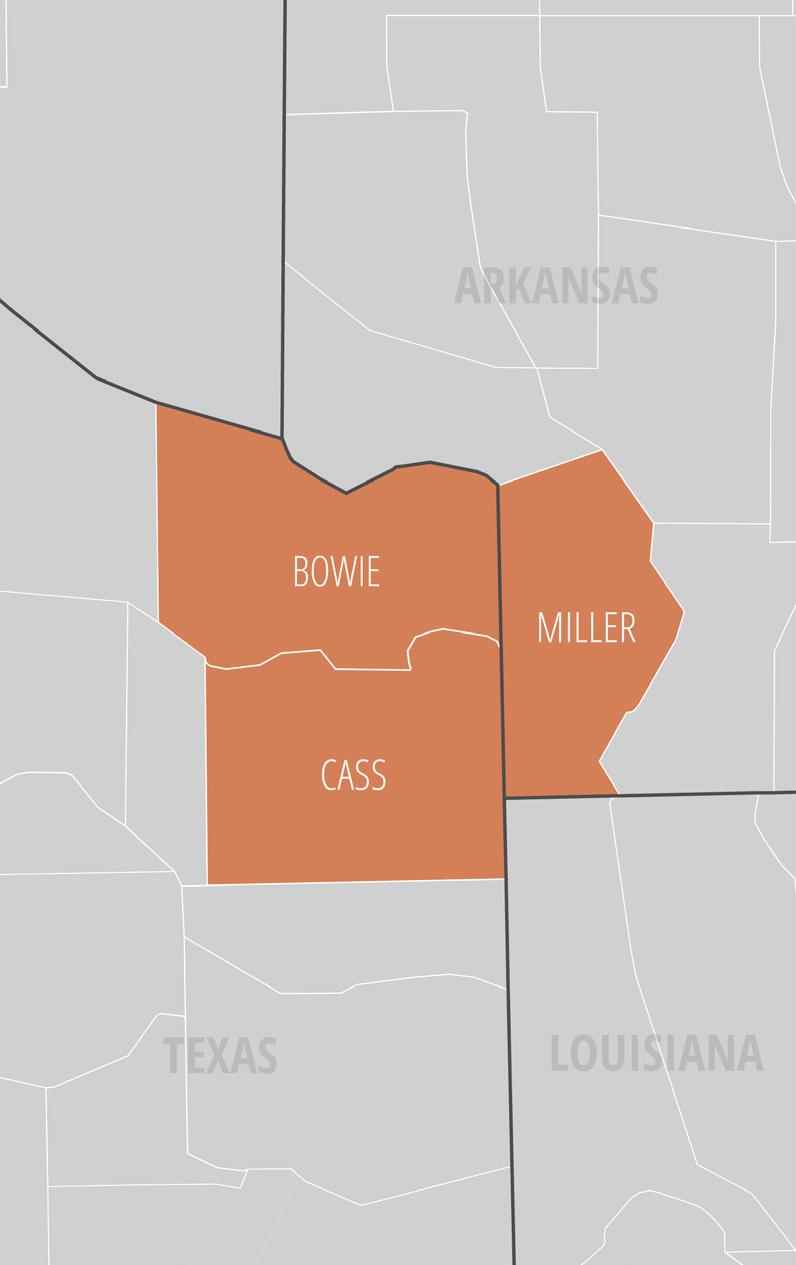
3 minute read
EXECUTIVE SUMMARY
TEXARKANA REGION SUMMARY

KEY FINDINGS
The Situation
In terms of employment growth, the Texarkana region has consistently underperformed Texas and the US, and never fully recovered from the Great Recession before being hard-hit by Pandemic. Although two of its top industry sectors—retail and government—have been losing jobs, healthcare and manufacturing have made substantial gains. These two sectors are expected to continue to expand, bringing better paying, higher skill jobs to the region and setting the stage for a more robust future. Economic Drivers
The Texarkana region has a small cluster related to forestry and forest products, which shows up in the region’s industry and occupational strengths. Other important economic drivers include healthcare and manufacturing. Workforce Demand
Like the rest of the country, the Texarkana region has experienced a decline of middle-skill, middle-wage jobs, and this trend is expected to continue. These jobs require more than a high school diploma and less than a four-year degree. However, demand for higher skill jobs is growing. In-demand jobs that pay $15 per hour or higher include a wide range of middle- and high-skill jobs in occupational families such as healthcare practitioners, education & training, transportation, and maintenance and repair. Most of the highskill occupations face below average automation risk; middle-skill occupations are more likely to face higher than average automation risk. Educational Infrastructure and Alignment
The region has 20 school districts and two public higher education institutions. Of the 1,400 high school graduates that can be tracked, about 70 percent are employed and 58 percent are enrolled in a postsecondary program. Of the students that are employed, about two-thirds work in retail or accommodations and food services. Of the students that are enrolled, the top destinations are Texarkana College, Northeast Texas Community College, and Texas A&MTexarkana. Texarkana College is the largest source of talent in the region, and Texas A&MTexarkana is a great source for talent with fouryear degrees or higher. These two institutions graduate about 1,300 students, which is fewer than the number of entry-level openings requiring a postsecondary degree. In other words, the talent pipeline from regional institutions falls short of demand. In particular, the regional postsecondary institutions are graduating only about 30 percent of the entry-level workers needed for health science and about 70 percent of the workers needed for education & training programs.
COUNTIES

KEY STATISTICS
166,528
Population (2019)
-0.2%
Population Change (2014-2019)
68,083
Jobs (2020)
39,571
Openings (2021-2026)
EMPLOYMENT BY INDUSTRY
Healthcare Retail Trade Government Education Accommodation & Food Services Manufacturing Construction Other Services (except Public Administration) Administrative & Support Services Transportation & Warehousing Wholesale Trade Finance & Insurance Professional, Scientific, & Technical Services Real Estate & Rental & Leasing Agriculture, Forestry, Fishing & Hunting Arts, Entertainment, & Recreation Management of Companies & Enterprises Utilities Information Mining, Quarrying, & Oil & Gas Extraction 3,620 3,615 2,974 2,940 2,474 1,808 1,478 896 759 528 427 317 314 301 8,228 7,558 6,746 6,626 5,581 10,891
TOP HIGH-DEMAND, HIGH-WAGE JOBS*
OCCUPATION
1. Heavy & Tractor-Trailer Truck Drivers 2. First-Line Supervisors of Food Preparation & Serving Workers 3. Registered Nurses 4. First-Line Supervisors of Retail Sales Workers 5. General & Operations Managers 6. Correctional Officers & Jailers 7. Medical Secretaries & Administrative Assistants 8. Elementary School Teachers, Except Special Education 9. Bookkeeping, Accounting, & Auditing Clerks 10. Welders, Cutters, Solderers, & Brazers 11. Licensed Practical & Licensed Vocational Nurses
OPENINGS (2021-2026)
864 491 476 450 384 335 319 310 304 301 300 12. Maintenance & Repair Workers, General 289 13. Secondary School Teachers, Except Special & Career/Tech. Education 266 14. First-Line Supervisors of Office & Administrative Support Workers 250 15. Project Mgmt. Specialists & Business Operations Specialists, All Other 242
Source: Emsi 2021.2 – QCEW Employees, Non-QCEW Employees, and Self-Employed. Page 2 header image by Jay Brittain. * Includes only occupations that pay more than $15.00 an hour and require some kind of postsecondary education.

Image by Michael Barera via Wikimedia Commons






